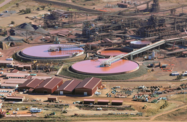President Jacob Zuma has announced a shake-up of the South African energy sector after signalling the government will push ahead with both nuclear energy generation and shale gas exploration, although revised electricity demand projections suggest consumption will nonetheless be slower than expected in the years until 2025.
Speaking in his state of the nation speech in June, Zuma reiterated his desire to speed up the delivery of energy generation. Key among them will be the restructuring of the energy industry, which proposes to separate Eskom’s generation and transmission businesses, as well as fast-track electricity generation projects and nuclear energy procurement plans.
Coal-fired economy
Eskom, South Africa’s parastatal power utility, produces around 95% of the electricity consumed in the country and about 45% of the electricity consumed in Africa – a measure of the poor state of generation elsewhere on the continent. However, the firm has been battling to meet the growing call for energy, with many of its ageing power stations running at below capacity or out of commission.
This became evident earlier this year when the utility began load-shedding to alleviate pressure on the network, after heavy rains soaked coal stockpiles leaving them largely unusable. Eskom currently uses coal for 80% of the electricity it generates, with the vast majority of output provided by 13 coal-fired power stations, three of which (Grootvlei, Camden and Komati) have recently been recommissioned and returned to service. The bulk of the balance is largely sourced from gas-liquid fuel turbine stations and to a lesser extent, hydroelectric facilities and a single 1800-MW nuclear plant.
Eskom plans to retire many of its old power stations between 2020 and 2030 and replace this lost capacity partly with nuclear sources.
After underinvestment throughout the late 1990s, the firm has launched an extensive capacity-boosting programme, aiming to add nearly 11,000 MW of new production to its existing 42,500 MW of capacity by 2017 and refurbish old plants. Between 2005 and 2013, Eskom spent roughly R385bn ($35.78bn) on expanding generating facilities, including two large new coal-fired plants at Kusile and Medupi, to ensure there is sufficient supply to meet demand over the long-term.
Demand may slacken
Revised forecasts for South Africa's long-term electricity consumption have resulted in lower estimates for demand, although in the short- and medium-term, the urgency for expanding both capacity and infrastructure remains.
Yet while demand is undoubtedly still rising, the pace of the increase now appears to be less than previously forecast.
South Africa’s Energy Research Centre has estimated energy demand at 341 TWh in 2030, compared with the 454 TWh forecast by the original energy blueprint in 2010. If this scenario, based in part on lower projections of economic growth, proves to be correct, South Africa could opt for a larger mix of nuclear, hydro, shale gas and renewables to meet its electricity needs through to 2040 and possibly beyond.
Powering the economy
The IRP, finalised in 2011, represents the nation’s roadmap to meet the expected demand. Initiated by the DoE after a round of public participation in 2010, the IRP is to be revised regularly, to keep the objectives in line with the evolving economic environment. This has already resulted in a number of changes that have increased the allocation of renewables and natural-gas-fired, open-cycle turbines and reduced the initial allocation of combined-cycle gas turbines used for peaking.
The current iteration of the IRP sets a number of targets for the 2030 national energy mix in terms of new build which, if met, will result in 22.6% of added capacity being derived from nuclear technology; 14.7% from coal; 6.1% from imported hydro; 9.2% from open-cycle gas; 5.6% from combined-cycle gas; and 41.8% from renewables.
Going nuclear
The identification of nuclear technology as a major contributor to the future energy mix has rekindled enthusiasm in an industry that has seen little development since the establishment of the Koeberg plant in the mid-1980s. While many countries are shelving plans for nuclear generation, South Africa is still pushing ahead. Not only is the Koeberg plant in the midst of a $350m tender to replace six steam generators, but Energy Minister Ben Martins said in mid-April that the country would decide on definitive build plans for nuclear power in the second half of the year.
Even with the revised forecasts for demand, nuclear power will provide a significant boost to generating capacity. According to Phumzile Tshelane, chief executive of the state-owned Nuclear Energy Corporation of South Africa (Necsa), demand is in part subdued due to the supply capacity. “As soon as supply constraints are removed, natural demand will be restored and be higher than the current rate,” Tshelane told OBG.
The development of a nuclear power capacity is necessary for the development of the economy and to promote energy security, while there will be a number of spin offs for both the public and private sectors, he said, adding that the private sector could play a role in construction.
There have been some concerns that the nuclear option may prove expensive. A study conducted by Eskom in 2010 budgeted a production cost of $5300 per KW, more than twice that of China and South Korea, which were building nuclear power production capacity at an average of $2000 per KW.
However, even with lower demand forecasts, the need is clear for South Africa to diversify its generating facilities and strengthen transmission and distribution infrastructure and given the long-term benefits of nuclear production, it is likely that all options will remain on the table.
Follow Oxford Business Group on Facebook, Google+ and Twitter for all the latest Economic News Updates. Or register to receive updates via email.

